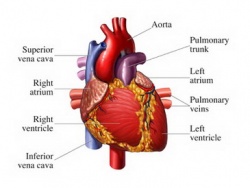Difference between revisions of "Heart"
(Created page with "thumb|250px| The heart (''hadaya'') is a specialized four-chambered muscle which pumps blood through the body. It is one of the 31 parts of the body, accord...") |
|||
| (2 intermediate revisions by 2 users not shown) | |||
| Line 1: | Line 1: | ||
[[File:HEART.jpg|thumb|250px|]] | [[File:HEART.jpg|thumb|250px|]] | ||
| − | The heart (''hadaya'') is a specialized four-chambered muscle which pumps blood through the body. It is one of the 31 parts of the body, according to the early Buddhist analysis. In non-philosophical discourse throughout the Tipiṭaka the word | + | The [[heart]] (''[[hadaya]]'') is a specialized four-chambered muscle which pumps {{Wiki|blood}} through the [[body]]. It is one of the 31 parts of the [[body]], according to the early [[Buddhist]] {{Wiki|analysis}}. In non-philosophical {{Wiki|discourse}} throughout the [[Tipiṭaka]] the [[word]] ‘[[heart]]’ is used where we would expect to see the [[word]] ‘[[mind]]’ and the [[heart]] itself is often associated with various [[emotions]]. We read of someone’s ‘[[heart]] breaking with sorrow’(Ja.V,180), of having a ‘[[calm heart]]’ (A.V,64), a ‘[[distraught heart]] (Ja.IV,415) and of ‘[[knowing another person’s heart]]’ (M.I,32). The [[Buddha]] said that his words ‘[[go right to the heart]]’ (''[[hadayaṃgamā]]''). Early [[abhidhamma]] thinkers considered the question of what could be the [[physical]] seat of [[consciousness]], although they never decided on any particular {{Wiki|organ}}. Later [[abhidhamma]] speculation decided that it was the [[heart]] (''[[hadayavatthu]]''). Today we know that the [[brain]]''[[matthaluṅga]]'') is the [[physical]] basis of [[consciousness]], although it is true that we seem to [[feel]] certain strong [[emotions]] in the {{Wiki|solar}} plexus just near the [[heart]]. |
{{R}} | {{R}} | ||
[http://www.buddhisma2z.com/content.php?id=168 www.buddhisma2z.com] | [http://www.buddhisma2z.com/content.php?id=168 www.buddhisma2z.com] | ||
[[Category:Buddhist Terms]] | [[Category:Buddhist Terms]] | ||
Latest revision as of 07:02, 14 December 2013
The heart (hadaya) is a specialized four-chambered muscle which pumps blood through the body. It is one of the 31 parts of the body, according to the early Buddhist analysis. In non-philosophical discourse throughout the Tipiṭaka the word ‘heart’ is used where we would expect to see the word ‘mind’ and the heart itself is often associated with various emotions. We read of someone’s ‘heart breaking with sorrow’(Ja.V,180), of having a ‘calm heart’ (A.V,64), a ‘distraught heart (Ja.IV,415) and of ‘knowing another person’s heart’ (M.I,32). The Buddha said that his words ‘go right to the heart’ (hadayaṃgamā). Early abhidhamma thinkers considered the question of what could be the physical seat of consciousness, although they never decided on any particular organ. Later abhidhamma speculation decided that it was the heart (hadayavatthu). Today we know that the brainmatthaluṅga) is the physical basis of consciousness, although it is true that we seem to feel certain strong emotions in the solar plexus just near the heart.
